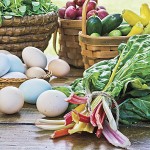 If there really is such a thing as genetic memory, then my genes remember being down on the farm. I have romantic notions of growing my own vegetables. I want backyard chickens. I picture an array of colorful vegetables waiting to be canned nestled beside a wire basket of fresh brown, blue and green eggs sitting on my counter. You know, like you see in Southern Living.
If there really is such a thing as genetic memory, then my genes remember being down on the farm. I have romantic notions of growing my own vegetables. I want backyard chickens. I picture an array of colorful vegetables waiting to be canned nestled beside a wire basket of fresh brown, blue and green eggs sitting on my counter. You know, like you see in Southern Living.
There’s a small problem, though. I hate gardening and yard work!You see, I’m a suburbanite through and through. I like my air conditioning and my supermarket on the corner. I enjoy a quick pop and shop at the nearby mall. Can’t live without Target
The one thing in my life where the farm-girl gene does play out is cooking and baking. I LOVE them. Right now, I’m into baking bread again. It’s been an on-again-off-again thing for me. I can handle flour stuck to my hands. Black dirt? No so much.But when I began researching what my heroine’s life would have been like in rural France during World War II for When We Get to Paris, my story in ENCHANTED BY AN EMERALD boxed set, I was inspired.
Life was hard around the world during the war. Everything from flour and sugar to rubber and nylon was rationed. People on the home front did what they had to so their soldiers could fight the good fight.
Simone Bellamy, my heroine in When We Get to Paris, lives on an apple orchard that has been in her family for generations in the Normandy area of France. Historically, her orchard has produced cider and the Calvados brandy for which the area is famous. My dilemma as the author, was to figure out how Simone would support herself when the war came to her front door.
Simone had to keep working, even harder than she had before the war. Because of the war, she must rely on her hens for enough eggs to sell as well as feed her family. She must ration the milk from her two cows so she has enough to make butter and cheese to take to market.
Learning about making brandy, cider and cheese was interesting. But the thing I was truly fascinated with was the assets French Angora rabbits are to a woman in Simone’s situation.
 The French Angora rabbit reproduces rapidly, like all rabbits. When mature, one rabbit will provide eight to ten pounds of meat. But the wool is the real boon. The Angora rabbit produces the silky soft wool used in making Agnora sweaters.
The French Angora rabbit reproduces rapidly, like all rabbits. When mature, one rabbit will provide eight to ten pounds of meat. But the wool is the real boon. The Angora rabbit produces the silky soft wool used in making Agnora sweaters.
And, you don’t need to kill the rabbit to get the wool. Angora wool is spun from the top coat, or the molted coat, of the rabbit. There’s a fabulous video of a woman spinning yarn right off the rabbit’s back as it sits contentedly in her lap. The wool is in continuous supply since the rabbits molt every three months.
Here’s a video showing how easy it is to spin from the rabbit.


 Available September 8, 2014! At all online e-book retailers.
One enchanted emerald…seven couples in need of its magic to find true love.
Available September 8, 2014! At all online e-book retailers.
One enchanted emerald…seven couples in need of its magic to find true love.